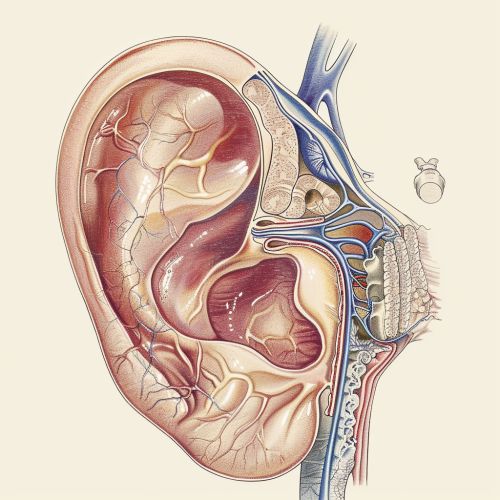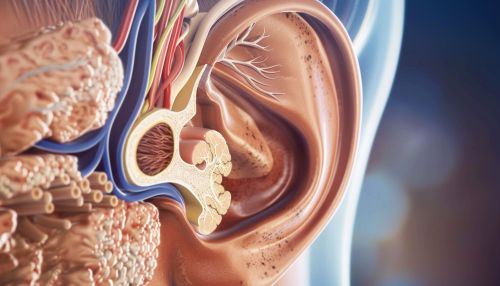Binaural hearing
Introduction
Binaural hearing refers to the ability of an organism to perceive sound using both ears. This auditory phenomenon is crucial for localizing sound sources, understanding speech in noisy environments, and perceiving the spatial attributes of sound. Binaural hearing is a complex process that involves the integration of auditory information from both ears in the brain, allowing for a richer and more detailed auditory experience.
Anatomy and Physiology of Binaural Hearing
Outer and Middle Ear
The outer ear, consisting of the pinna and ear canal, captures sound waves and funnels them towards the eardrum. The middle ear, comprising the ossicles (malleus, incus, and stapes), amplifies these sound waves and transmits them to the inner ear. The structure of the outer and middle ear plays a significant role in the initial phase of sound localization.
Inner Ear
The inner ear contains the cochlea, a spiral-shaped organ filled with fluid and lined with hair cells. These hair cells convert mechanical sound vibrations into electrical signals, which are then transmitted to the brain via the auditory nerve. The cochlea is tonotopically organized, meaning different frequencies of sound stimulate different regions of the cochlea.
Auditory Pathways
The auditory signals from both ears travel through the auditory nerve to the brainstem, where they are processed by several nuclei, including the cochlear nucleus, superior olivary complex, and inferior colliculus. The superior olivary complex is particularly important for binaural hearing as it is involved in the detection of interaural time differences (ITDs) and interaural level differences (ILDs).


Mechanisms of Binaural Hearing
Interaural Time Differences (ITDs)
ITDs refer to the difference in the time it takes for a sound to reach each ear. This time difference is crucial for localizing low-frequency sounds. The brain can detect ITDs as small as a few microseconds, allowing for precise localization of sound sources in the horizontal plane.
Interaural Level Differences (ILDs)
ILDs refer to the difference in the sound pressure level reaching each ear. This difference is more pronounced for high-frequency sounds due to the head-shadow effect, where the head obstructs the sound waves, causing a reduction in sound intensity at the far ear. ILDs are essential for localizing high-frequency sounds.
Head-Related Transfer Function (HRTF)
The HRTF describes how the shape of the head, ears, and torso affect the sound waves reaching the eardrums. Each individual has a unique HRTF, which helps in the vertical localization of sound and the perception of sound elevation.
Binaural Hearing in Different Environments
Quiet Environments
In quiet environments, binaural hearing allows for the precise localization of sound sources. The absence of background noise enables the auditory system to rely heavily on ITDs and ILDs for accurate sound localization.
Noisy Environments
In noisy environments, binaural hearing helps in distinguishing speech from background noise. This phenomenon, known as the Cocktail Party Effect, relies on the brain's ability to focus on a specific sound source while filtering out irrelevant noise. Binaural cues, such as ITDs and ILDs, play a crucial role in this process.
Reverberant Environments
In reverberant environments, where sound waves reflect off surfaces, binaural hearing helps in perceiving the spatial attributes of sound. The brain uses the direct sound and its reflections to create a sense of space and distance, enhancing the overall auditory experience.
Applications of Binaural Hearing
Hearing Aids and Cochlear Implants
Modern hearing aids and cochlear implants are designed to preserve binaural hearing by ensuring that both ears receive synchronized auditory signals. This synchronization is crucial for sound localization and speech understanding in noisy environments.
Virtual Reality and Gaming
Binaural audio technology is widely used in virtual reality (VR) and gaming to create immersive auditory experiences. By simulating ITDs, ILDs, and HRTFs, binaural audio can create a realistic 3D sound environment, enhancing the user's sense of presence.
Audiology and Psychoacoustics
In the field of Audiology, binaural hearing assessments are used to diagnose and treat hearing disorders. Psychoacoustic research investigates how the brain processes binaural cues, contributing to the development of advanced auditory prosthetics and audio technologies.
Research and Future Directions
Neural Mechanisms
Ongoing research aims to unravel the neural mechanisms underlying binaural hearing. Advanced imaging techniques, such as functional MRI and electrophysiology, are used to study the brain regions involved in processing binaural cues.
Binaural Hearing in Non-Human Animals
Studies on non-human animals, such as bats and owls, provide insights into the evolution and adaptation of binaural hearing. These animals have specialized auditory systems that allow for precise sound localization, even in challenging environments.
Technological Advancements
Future advancements in binaural audio technology may lead to more sophisticated hearing aids, cochlear implants, and VR systems. Research in this area focuses on improving the accuracy and realism of binaural audio simulations.
